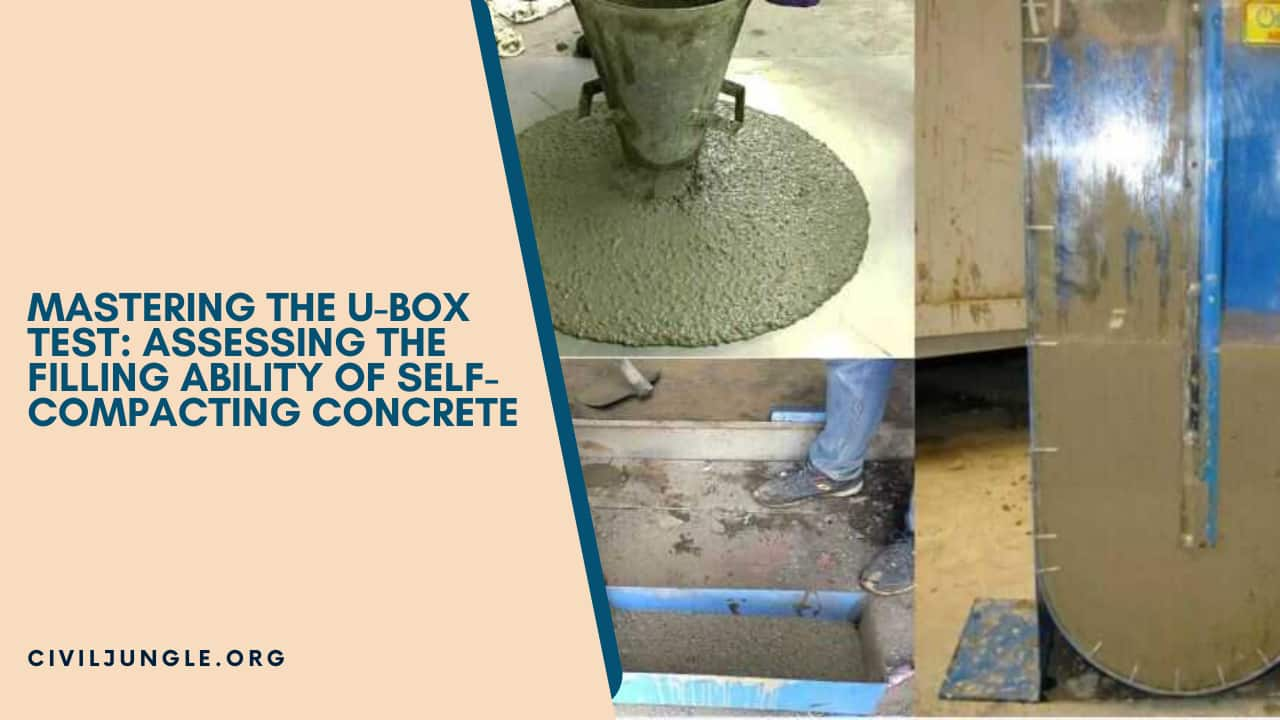
What Is Self Compact Concrete?
Making concrete structures without vibration has been done in the past. For example, the placement of concrete under-water is done by the use of tremie without vibration. Shaft concrete and mass concrete may be successfully placed without vibration.
But the above examples of concrete are normally of lower strength and difficult to obtain consistent quality. Modern application of SCC (self-compacting concrete) is focussed on high performance, better and more reliable, and uniform quality.
List of Test Methods for Workability Properties of Self Compacting Concrete (SCC).
- Slump flow by Abrams cone.
- T50 cm Slump flow
- J-ring
- V-funnel
- V-funnel at T5 minutes
- L-box
- U-box
- Fill-box
- GTM Screen Stability Test
- Ouimet
In this article, we are discussion & Procedure Slump Flow Test
What Is U Box Test?

The test was developed in Japan The test is used to measure the filling ability of self com, pacting concrete. The apparatus consists of a vessel that is divided by a middle wall into two compartments shown by R1 and R2 in Show in Figure. An opening with a sliding gate is filled between the two compartments.
Reinforcing bars with a nominal diameter of 13 mm is installed at the gate with the center to center distance of 50 mm. This creates a clear spacing of 35 mm between the bars. The left-hand section is filled with about 20 liters of concrete. The gate is then lifted and the concrete flows to the other section. The height of concrete in both sections is measured.
Equipment U-Box Test:
1. U-Box

U-box of a stiff non absorbing material
2. Trowel

This tool is used to place cement mortar.
3. Scoop

This use in QC department for the material.
4. Stopwatch

Use for time record
Procedure U-Box Test:
- About 20 litre of concrete is needed for this test.
- Ensure that sliding gate can open freely and then close it.
- Moisten the inside surface and remove any surplus water.
- Fill the one compartment of the apparatus with about 20 litre concrete.
- Leave it to stand for 1 minute.
- Lift the sliding gate and allow the concrete to flow to the other compartment.
- Once the concrete has come to rest, measure the height of the concrete in the second compartment in two places.
- Calculate the mean. Let it be H2. The height of concrete in the 1st compartment be H1.
- Calculate H1 – H2 the filling height. The whole test has to be completed within 5 minutes.
Calculations U-Box Test:
- Filling time, Express the measured filling time, TU (sec) = ______ sec
- Height in the pouring compartment (H1) = _______
- Height in the other compartment (H2) = ______
- Calculate (H1– H2) = ________
Results U-Box Test:
The filling height of self compacting concrete is ______
Significance U-Box Test:
- If the concrete flows as freely as water, at rest it will be horizontal, so H1– H2 = 0.
- Therefore the nearer this test value, the ‘filling height’, is to zero, the better the flow and passing ability of the concrete.
FAQs (Frequently Asked Questions) that you can include in your article about the U-Box test for self-compacting concrete:
What is the U-Box test used for?
The U-Box test is used to measure the filling ability of self-compacting concrete (SCC). It assesses how well the concrete flows and fills a designated space, indicating its workability and ability to pass through congested reinforcement.
How does the U-Box test work?
The test involves filling one compartment of the U-Box apparatus with SCC, then lifting a sliding gate to allow the concrete to flow into another compartment. The difference in height between the two compartments (H1 – H2) is measured to determine the filling height, which indicates the concrete’s flowability.
What equipment is required for the U-Box test?
Essential equipment includes the U-Box apparatus made of stiff, non-absorbing material, a trowel for placing the concrete, a scoop for material handling, and a stopwatch for timing the test procedure.
What are the key calculations in the U-Box test?
The test involves calculating the filling time (TU), measuring the height of concrete in both compartments (H1 and H2), and determining the filling height (H1 – H2). A lower filling height indicates better flow and passing ability of SCC.
What are the results and significance of the U-Box test?
The results provide insight into how freely SCC flows compared to water. A filling height closer to zero indicates excellent flow properties, essential for ensuring uniform distribution and thorough filling around reinforcement in structural applications.
Why is the U-Box test important in construction?
It helps engineers and contractors assess the workability and performance of SCC, ensuring it meets the required standards for structural integrity and durability without the need for vibration during placement.

